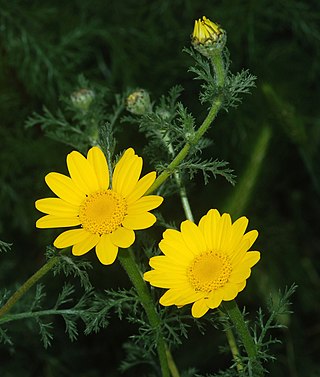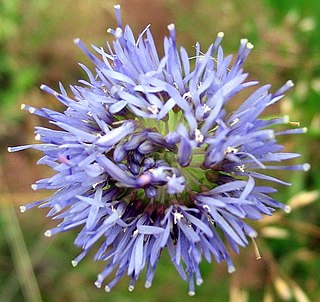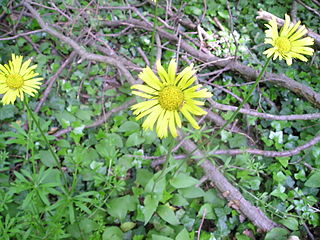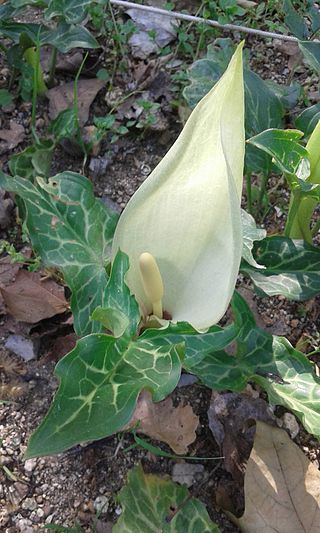
Oregano is a species of flowering plant in the mint family Lamiaceae. It was native to the Mediterranean region, but widely naturalised elsewhere in the temperate Northern Hemisphere.

Juniperus communis, the common juniper, is a species of small tree or shrub in the cypress family Cupressaceae. An evergreen conifer, it has the largest geographical range of any woody plant, with a circumpolar distribution throughout the cool temperate Northern Hemisphere.

Chamaecytisus is a genus of flowering plants in the legume family, Fabaceae. It includes 43 species which range from the Canary Islands and Morocco through mainland Europe to western Siberia, Kazakhstan, the Caucasus, Anatolia, and the eastern Mediterranean. It belongs to the subfamily Faboideae. It may be a synonym of Cytisus.

Cota tinctoria, the golden marguerite, yellow chamomile, or oxeye chamomile, is a species of perennial flowering plant in the sunflower family. Other common names include dyer's chamomile, Boston daisy, and Paris daisy. In horticulture this plant is still widely referred to by its synonym Anthemis tinctoria.

Verbascum is a genus of over 450 species of flowering plants, common name mullein, in the figwort family Scrophulariaceae. They are native to Europe and Asia, with the highest species diversity in the Mediterranean.

Anthemis is a genus of aromatic flowering plants in the family Asteraceae, closely related to Chamaemelum, and like that genus, known by the common name chamomile; some species are also called dog-fennel or mayweed. Anthemis are native to the Mediterranean region and southwest Asia east to Iran. A number of species have also become naturalized in the United Kingdom and other parts of the world.

Lavandula angustifolia, formerly L. officinalis, is a flowering plant in the family Lamiaceae, native to the Mediterranean. Its common names include lavender, true lavender and English lavender ; also garden lavender, common lavender and narrow-leaved lavender.

Jasione is a genus of flowering plants within the family Campanulaceae. It includes 14 species native to Europe, Turkey, and northwestern Africa.

Doronicum is a genus of flowering plants in the sunflower family, known as leopard's bane. They are all herbaceous perennials native to Europe, southwest Asia and Siberia. They produce yellow, daisy-like flowerheads in spring and summer.

Doronicum orientale, the Oriental leopard's bane, is a European plant species in the family Asteraceae.

Arum italicum is a species of flowering herbaceous perennial plant in the family Araceae, also known as Italian arum and Italian lords-and-ladies. It is native to the British Isles and much of the Mediterranean region, the Caucasus, Canary Islands, Madeira and northern Africa. It is also naturalized in Belgium, the Netherlands, Austria, Argentina, North Island New Zealand and scattered locations in North America.

Doronicum grandiflorum is a European species of Doronicum, a member of the family Asteraceae.

Farfugium japonicum is a species of flowering plant in the family Asteraceae, also known as leopard plant, green leopard plant or tractor seat plant. It is native to streams and seashores of Japan, where it is called tsuwabuki (石蕗).

The term bane, in botany, is an archaic element in the common names of plants known to be toxic or poisonous.

Myrtus communis, the common myrtle or true myrtle, is a species of flowering plant in the myrtle family Myrtaceae. It is an evergreen shrub native to southern Europe, North Africa, Western Asia, Macaronesia, and the Indian Subcontinent, and also cultivated.

Astrantia major, the great masterwort, is a species of flowering plant in the family Apiaceae, native to central and eastern Europe. Growing up to 90 cm (35 in) tall by 45 cm (18 in) broad, it is an herbaceous perennial, much used in gardens.

Doronicum plantagineum, the plantain-leaved leopard's-bane or plantain false leopardbane, is a European plant species in the sunflower family. It is native to southeastern Europe from Greece and Italy to Ukraine and the Czech Republic. There are reports of the species being naturalized in the State of Oregon in the northwestern United States.

Dianthus giganteus, the giant pink, is a species of pink native to Romania, the Balkan peninsula, and possibly nearby areas. A perennial with flowerheads reaching 1 m, it is useful in gardening and landscaping applications where a backdrop of taller plants is needed. It is available from commercial suppliers, with the Royal Horticultural Society considering it to be a good plant to attract pollinators.

Lachenalia orchioides, the orchid‑like Cape cowslip, is a species of flowering plant in the genus Lachenalia, native to the Cape Provinces of South Africa. It has gained the Royal Horticultural Society's Award of Garden Merit.

Pfeiffera monacantha, the one‑spined wickerware cactus, is a species of epiphytic cactus, native to Bolivia and northwest Argentina. As its synonym Rhipsalis monacantha it has gained the Royal Horticultural Society's Award of Garden Merit.




















